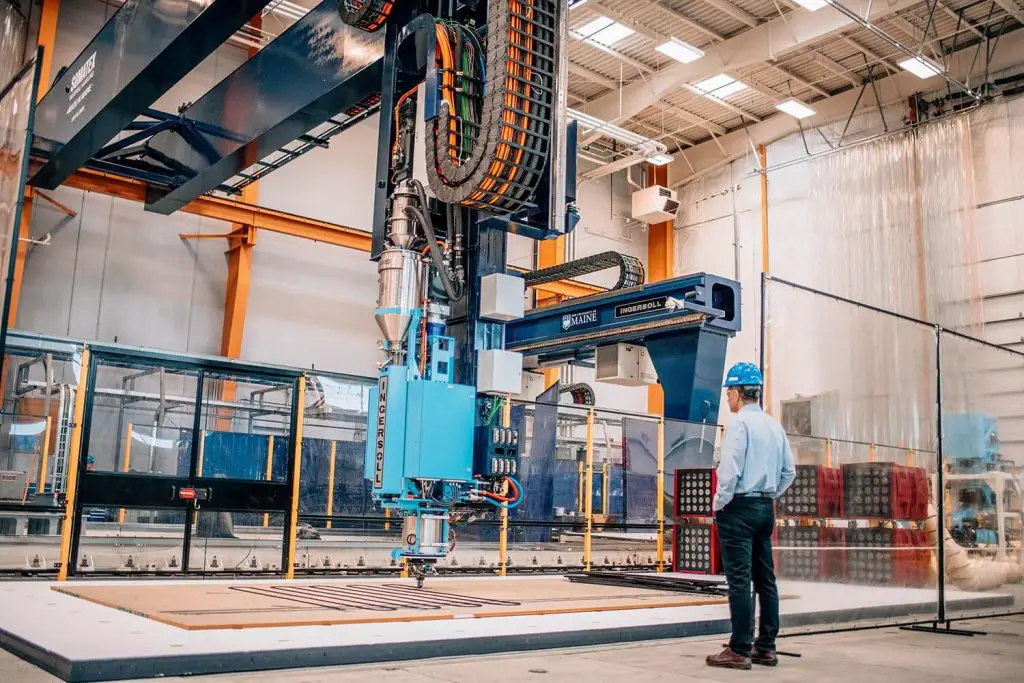University of Maine unveils world’s largest 3D printer. Can it create entire neighborhood one day?
Surpassing its own 2019 Guinness World Record for the largest polymer 3D printer, University of Maine unveiled a next-generation printer that is four times larger than its first one and capable of printing ever mightier objects.
The world’s largest 3D printer, dubbed Factory of the Future 1.0 (FoF 1.0), was unveiled on April 23 at the UMane’s Advanced Structures and Composites Center (ASCC). Those attending the event included the representatives from U.S. Department of Energy, representatives from the U.S. Department of Defense, the Maine State Housing Authority, industry partners, among other stakeholders.
The new thermoplastic polymer printer is designed to print objects as large as 96 feet long by 32 feet wide by 18 feet high (29 meters by 10 meters by 5.5 meters), and can print up to 500 pounds (227 kilograms) per hour. The new world’s largest 3D printer offers opportunities for eco-friendly and cost-effective manufacturing for numerous industries.
Read also: The World’s largest 3D-printed neighborhood
The world’s largest polymer 3D printer is not just a large-scale printer. It dynamically switches between various processes such as robotic arm operations, large-scale additive manufacturing, continuous tape layup, and subtractive manufacturing. Access to it and MasterPrint, the ASCC’s first world-record breaking 3D printer, will help streamline manufacturing innovation research at the University.
“FoF 1.0 opens up new research frontiers to integrate these collaborative robotics operations at a very large scale with new sensors, high-performance computing and artificial intelligence to create born-certified systems that meet high quality standards,” said ASCC Executive Director Habib Dagher. “We are grateful for Senator Collins’ support, for support from Maine’s congressional delegation and for collaborations with the Department of Defense, Department of Energy, Oak Ridge National Labs, Maine Housing and our industry partners here in Maine and beyond.”
Read also: 3D printing in construction: Building the future layer by layer

New world’s largest 3D printer boosts sustainability
The new world’s largest polymer 3D printer will advance various initiatives, including the development of biobased feedstocks from wood residuals abundant in Maine. This technology will advance commercialization efforts such as BioHome3D and the creation of sustainable, affordable housing, while also propelling crucial technological advancements for national security, particularly in lightweight rapidly deployable structures and vessel technologies.
“It’s not about building a cheap house or a biohome,” he added, referring to the first 3D-printed house made entirely with bio-based materials. “We wanted to build a house that people would say, ‘Wow, I really want to live there.’”
UMaine System Chancellor Dannel Malloy praised the University of Maine for hitting another big milestone in research and development. He thanked the state, federal, industry, and philanthropic partners for their steady support, which makes Maine’s progress possible. With the addition of word’s largest 3D printer and the upcoming Green Engineering and Materials Factory of the Future. Maine’s R1 university is poised to advance its global leadership in advanced manufacturing and materials science. This move ensures that the flagship university remains a top destination for education and research in engineering and computing. While also speeding up solutions that strengthen the state’s economy and communities.
Read also: 3D printing construction is here
The unveiling of the new world’s largest polymer 3D printer comes ahead of this summer’s planned groundbreaking of a 47,000-square-foot new research laboratory called the Green Engineering and Materials (GEM) Factory of the Future.
The original 3D printer isn’t being replaced. In fact, these two technologies can complement each other. Imagine them working together on a single project, perhaps even on different parts of the same object! Experts predict this collaborative approach will become even more common in the future.
Read also: How technology is changing the construction industry

